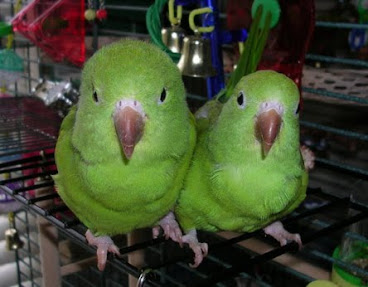Parakeet Cage
>> Friday, March 5, 2010
In breeding parakeets you have to choose the best parakeet cage for them. In choosing of an accommodation for your bird should be carefully considered, since the cage is the most important element of the furniture of your bird. Its size is one of the main factors of choice. It must be large enough to allow the bird to spread its wings and feathers flutter without hitting the bars.
Small birds, like canaries, lovebirds, budgies, finches and nymphs should be large enough to fly from perch to perch. Medium and large parrots need more space to enable them to climb and exercise inside the cage. For long-tailed birds (mainly parrots), will have to provide additional space to avoid spoiling the feathers of the same.
Choose your bird ever to larger accommodation that allows you to your home. It will never be big enough, but can quickly become too small. Your bird must share their space with toys, feeders, perches and maybe some swing, ladder or other accessory. Note also that you may later decide to buy another bird.
The style of crate you choose depends largely on your personal taste, but always rejected circular cages. In a square or rectangular cage, the bird is always a "security side, usually the closest to the wall, where he knows he is not going to bring anyone unexpectedly. A round cage without this reference point, generating a significant stress to the animal's life, with all the disadvantages that implies (nervousness, depression defenses, etc.).
The distance between bars should be wide enough to avoid trapping the beak or claws, but not so large to allow the head to enter through them. There is also the question of whether the cage should have a horizontal or vertical grating. Seems most optimal side walls are horizontal and the vertical front and rear. The side used for a comfortable and perched on the bird before and after the peak used both as the claws, which requires more energy and thus greater consumption of calories. This will help keep our birds in top form.
We observe that the welds are smooth, polished, so the bird can not damage or scratch us during cleaning. Furthermore, the material of construction of a good accommodation for birds should be carefully chosen. Smooth surfaces can, over time, show scratches, chips or stains. These areas should always be sealed without heavy metals. Often parrots can eat these things out that in case of containing heavy metals, would cause fatal poisoning.
Surfaces powder-coating (dust coating) have been the most appropriate for the last twenty years, but again has to be careful in the preparation. If the powder-coating performed flawlessly and has been subjected to temperatures of at least 220 º C, the cage will have a long life.
We must also wear phenomena have, but if not used harsh cleaning products are removed regularly and food debris, feces and splashing water, the cages can be kept in perfect condition over many years.
Never use metal polishes for your cage. Most are toxic to your bird. Attention should be paid to that enhancements are appropriate and tailored to the needs and care of the bird. It is very useful and convenient feeders have stainless steel corners accessible and easy to clean, protective systems to avoid contaminating the environment of the cage, etc..
Your bird should be placed in the room of the house in which increased activity develops. Then you can observe the family and integrate more quickly.
Never place the cage near a source of heat or cold, such as windows, radiators, fireplaces, air conditioning and exterior doors. Resist the temptation to put your parrot in the kitchen, it smells and sharp fluctuations in temperature can be harmful. The fumes produced by overheated Teflon utensils can be fatal to your bird.
Never place it directly under sunlight without at least a portion of housing exists in the shade. Birds can also suffer heat stroke. He also thinks that the air near the ground is always colder.
If you have other pets, you should then place the cage away from the tooth and nail for them. Note that many ornamental plants are toxic to birds, so care should be paid that are not within reach. Watching all these aspects will find happier you and your feathered friend.



